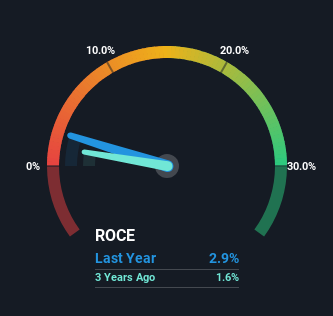- Israel
- /
- Renewable Energy
- /
- TASE:ENLT
Enlight Renewable Energy (TLV:ENLT) Is Doing The Right Things To Multiply Its Share Price
What trends should we look for it we want to identify stocks that can multiply in value over the long term? Typically, we'll want to notice a trend of growing return on capital employed (ROCE) and alongside that, an expanding base of capital employed. This shows us that it's a compounding machine, able to continually reinvest its earnings back into the business and generate higher returns. With that in mind, we've noticed some promising trends at Enlight Renewable Energy (TLV:ENLT) so let's look a bit deeper.
Understanding Return On Capital Employed (ROCE)
For those who don't know, ROCE is a measure of a company's yearly pre-tax profit (its return), relative to the capital employed in the business. To calculate this metric for Enlight Renewable Energy, this is the formula:
Return on Capital Employed = Earnings Before Interest and Tax (EBIT) ÷ (Total Assets - Current Liabilities)
0.029 = US$118m ÷ (US$4.6b - US$574m) (Based on the trailing twelve months to March 2024).
Thus, Enlight Renewable Energy has an ROCE of 2.9%. On its own that's a low return on capital but it's in line with the industry's average returns of 2.9%.
Check out our latest analysis for Enlight Renewable Energy

In the above chart we have measured Enlight Renewable Energy's prior ROCE against its prior performance, but the future is arguably more important. If you're interested, you can view the analysts predictions in our free analyst report for Enlight Renewable Energy .
How Are Returns Trending?
We're glad to see that ROCE is heading in the right direction, even if it is still low at the moment. Over the last five years, returns on capital employed have risen substantially to 2.9%. Basically the business is earning more per dollar of capital invested and in addition to that, 395% more capital is being employed now too. So we're very much inspired by what we're seeing at Enlight Renewable Energy thanks to its ability to profitably reinvest capital.
The Key Takeaway
To sum it up, Enlight Renewable Energy has proven it can reinvest in the business and generate higher returns on that capital employed, which is terrific. And with a respectable 99% awarded to those who held the stock over the last five years, you could argue that these developments are starting to get the attention they deserve. Therefore, we think it would be worth your time to check if these trends are going to continue.
One more thing, we've spotted 2 warning signs facing Enlight Renewable Energy that you might find interesting.
For those who like to invest in solid companies, check out this free list of companies with solid balance sheets and high returns on equity.
Valuation is complex, but we're here to simplify it.
Discover if Enlight Renewable Energy might be undervalued or overvalued with our detailed analysis, featuring fair value estimates, potential risks, dividends, insider trades, and its financial condition.
Access Free AnalysisHave feedback on this article? Concerned about the content? Get in touch with us directly. Alternatively, email editorial-team (at) simplywallst.com.
This article by Simply Wall St is general in nature. We provide commentary based on historical data and analyst forecasts only using an unbiased methodology and our articles are not intended to be financial advice. It does not constitute a recommendation to buy or sell any stock, and does not take account of your objectives, or your financial situation. We aim to bring you long-term focused analysis driven by fundamental data. Note that our analysis may not factor in the latest price-sensitive company announcements or qualitative material. Simply Wall St has no position in any stocks mentioned.
Have feedback on this article? Concerned about the content? Get in touch with us directly. Alternatively, email editorial-team@simplywallst.com
About TASE:ENLT
Enlight Renewable Energy
Operates a renewable energy platform in Israel, Central-Eastern Europe, Western Europe, and the United States.
Proven track record with moderate growth potential.
Market Insights
Community Narratives




